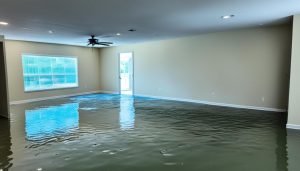Ever wondered how long it takes to dry walls after water damage? It’s not just about getting rid of dampness. Time is key when fixing water damage. Moisture can cause mold and harm the structure if not fixed fast.
The time it takes to dry walls depends on the damage, the materials, and the environment. Drying drywall can take from 24 hours to weeks. It’s vital to act quickly and correctly. To dry walls well, you might use dehumidifiers, fans, and moisture meters.
Knowing how to handle water damage is important. It keeps your home safe and healthy.
Key Takeaways
- Mold can start growing in wet areas within 24 to 48 hours, so prompt drying is crucial.
- Typical drying time for drywall ranges between 3 to 5 days.
- Water damage restoration can be more cost-effective than extensive repairs.
- Professional-grade dehumidifiers and air movers can accelerate the drying process.
- Incorrect drying methods can lead to more damage and mold growth.
- Moisture checks are essential during the drying process to prevent mold.
- Glossy paints may need to be perforated or removed to facilitate drying.
Factors Affecting Drying Time for Water-Damaged Walls
Many things can change how long it takes to dry water-damaged walls. Knowing these can help fix walls faster. These include the materials used, how much damage there is, the weather, air flow, and if mold or mildew is present.
The materials used in building matter a lot. Drywall, insulation, and wood soak up moisture at different rates. Thicker materials like drywall and insulation dry slower than thinner ones. For example, wooden boards in sheathing dry slowly and might warp, needing to be re-nailed after drying.
How much water damage there is also matters. Water from clean sources (Category 1) is easier and dries faster. But, water from greywater (Category 2) and blackwater (Category 3) is harder to clean up, making drying take longer.
Weather conditions like temperature and humidity affect drying times. High humidity slows things down, but good air flow speeds it up. Using fans, heaters, and dehumidifiers can help dry areas faster.
There are two main ways to dry: positive and negative pressure. Positive pressure is quicker but might spread bad particles. Negative pressure is slower but better for serious water damage. The right dehumidifier is also key. Adsorption dehumidifiers are faster but cost more energy. Condensation dehumidifiers are slower but can cut drying time by half and save energy.
Fixing hidden water damage needs careful checks to find hidden moisture.
Some steps can make drying faster. For example, removing vinyl wallpaper lets walls dry better. Insulation, which holds water, needs extra care. Using commercial dehumidifiers helps a lot. Experts use the right tools and methods to dry walls well, keeping costs and energy use down.
Steps to Dry Out Water-Damaged Walls
Water damage can quickly harm your walls, leading to mold and structural problems. It’s crucial to act fast and follow a systematic approach for drying and repair. This process includes several key steps:
- Identify the Source: First, find and fix the cause of the water damage. This could be a leaky pipe inside or a slope issue outside. Fixing these leaks is key to stopping further damage.
- Remove Damaged Materials: Next, remove the damaged drywall and insulation. This step is vital for fixing water damage behind the drywall. It also lets you access the water damage in the wall cavity.
- Drain Standing Water: For big damage, make small holes in the wall to drain water.
- Clean and Disinfect: Clean and disinfect the area to stop mold growth. Use a sanitizer to remove any remaining moisture.
- Dry the Area: Use fans, dehumidifiers, and open windows to dry the area. This step may take 48 hours or more to dry everything, including hidden wall cavities.
- Replace and Repair: After drying, put in new drywall and insulation. Use drywall screws, tape, and compound to secure them. Then, tape and mud the seams for a smooth finish.
- Prime and Paint: Apply a primer/sealer to the repaired area to keep moisture out. Then, paint to restore the wall’s look and protect it from future damage.
- Monitor for Mold: Watch the repaired area for mold or moisture. Quick action can stop small problems from getting bigger.
How long does it take to dry out walls from water damage?
The time it takes to dry walls from water damage varies. Minor damage might dry in a few days. But, bigger issues could take weeks. A good drying plan can speed up the process.
Using professional equipment like air movers and dehumidifiers is key. These tools, along with good air flow, make drying faster. For example, drying wet drywall usually takes 3-5 days.
It’s important to check moisture levels in walls to know when they’re dry. A moisture meter is needed for this. Any reading above 12% means the drywall needs more drying. If not dried, dampness can cause mold, especially after 48 hours.
Other things affect how long it takes to dry walls. These include the type of water damage, the area’s size, and how quickly the leak was stopped. Clean water damage is easier to fix and dries faster. But, grey or black water damage needs a pro because of harmful materials. Larger areas and structural issues also take longer.
Heating the house can help dry it faster. Warm air can hold more moisture. But, for serious cases, a pro should check it. They might need to replace the drywall for safety and structure.
The cost of fixing drywall varies with the damage’s extent. On average, it’s about $500, but can range from $250 to $750. Severe damage can cost more, showing the importance of quick and effective repair.
Conclusion
Dealing with water-damaged walls requires quick action and careful drying. Homeowners should watch for signs like brown stains and musty smells. Using the right tools and techniques is key to fixing walls and stopping future problems.
For big water damage, getting professional help is wise. Experts can handle tough issues. They use dehumidifiers and fans to dry walls and stop mold, which is harmful.
Insurance might help with the cost of fixing water damage. It’s important to call your insurance right away. Don’t try to fix water damage yourself, as it can cause more harm. Using the right materials and taking preventive steps is the best way to protect your home.








